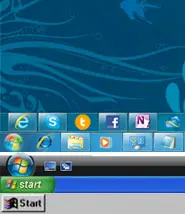Microsoft removed the Start menu because it wasn’t being used, and I’m not surprised
 The removal of Windows 8’s Start button is arguably one of the most controversial features in Microsoft’s radically different OS. Some people were outraged by the decision, while others (like myself) were more indifferent. At TechEd in Amsterdam this week, Microsoft principal program manager Chaitanya Sareen informed PC Pro that the Start menu was removed because, believe it or not, it wasn’t getting much use in Windows 7.
The removal of Windows 8’s Start button is arguably one of the most controversial features in Microsoft’s radically different OS. Some people were outraged by the decision, while others (like myself) were more indifferent. At TechEd in Amsterdam this week, Microsoft principal program manager Chaitanya Sareen informed PC Pro that the Start menu was removed because, believe it or not, it wasn’t getting much use in Windows 7.
Microsoft has, for many years, allowed customers to opt into the Customer Experience Improvement Program, which sends anonymous data to Microsoft about usage habits. The Redmond software giant has used this data to design the optimal ribbon size for Office applications, learn which features are used more than others, and much more. In the time since Windows 7 was released, Microsoft has seen a dramatic drop in Start menu usage.
My own usage patterns reflect the data Microsoft has gathered. I always pin my most-used programs to the taskbar, leaving the rest to reside in the “all programs” list. I would occasionally pin a few less-commonly-used programs to the Start menu, but the number of times I clicked on them was actually pretty low. Starting with Windows 7, Windows Explorer would default to the Libraries view, eliminating the need to use the Start menu’s quick shortcuts to Documents, Pictures, Music, Video, etc. Frankly, the Start menu essentially became a gigantic two-click shortcut for opening My Computer. It’s not quite as easy to get to My Computer or the Control Panel in Windows 8, but you need only open up Windows Explorer and click on Computer in the navigation pane on the left-hand side. Recently used documents are also integrated into Windows 7’s Jump Lists, yet again negating the need to open the Start menu.
As a result, the Start menu mainly served as a way to search through my applications or shut down the computer (which, for years, was the source of ridicule: “You mean I have to click on Start to shut down? How stupid is that?”). At this point, the Start menu was pretty much irrelevant in its current form. I much prefer Windows 8’s Start screen. I can still pin my favorite apps (complete with live tiles, for glance-and-go information), search, and shut down the computer with the Settings charm, so I’m not losing any functionality. Better still, the lack of a visual indicator (like a button) for the Start screen means that I have more room on the taskbar for desktop applications. Be honest: when was the last time you actually clicked on the Start button, rather than just shoving your mouse into the lower-left corner of the screen and letting Fitt’s Law do its thing?
So, yeah, Microsoft removed the Start button and drastically changed the Start menu into a Start screen. But I don’t care, because it can still do everything it could previously, and much more.
[PC Pro]

